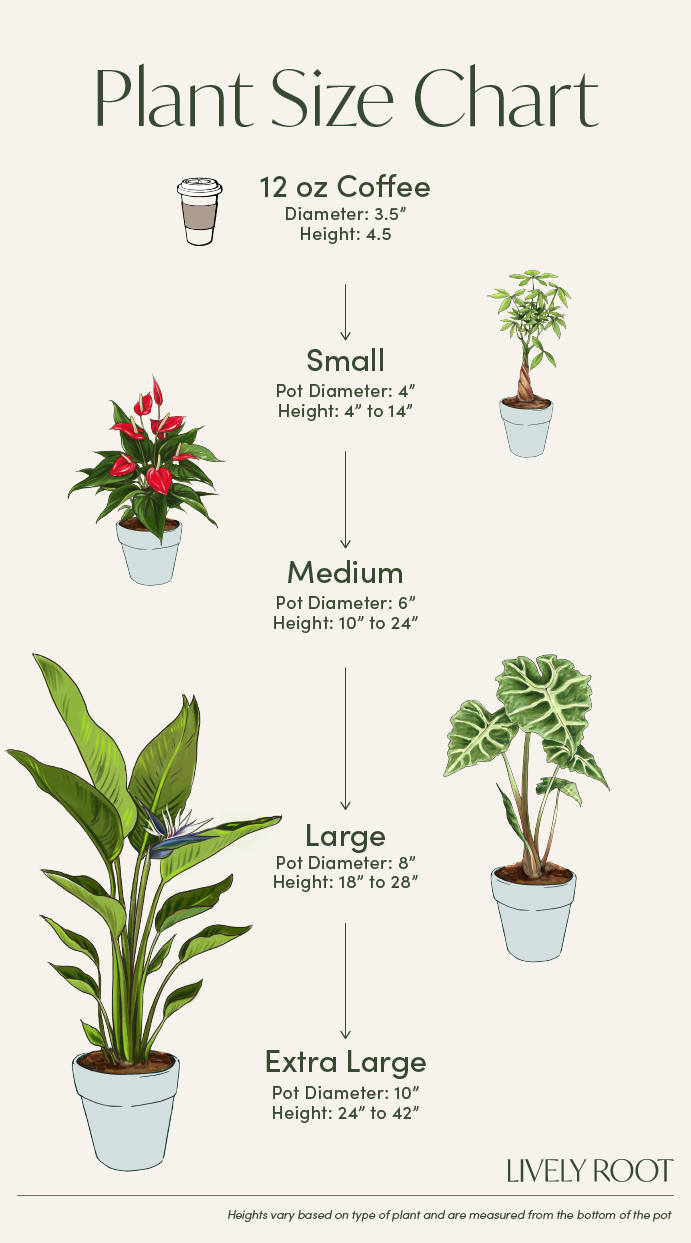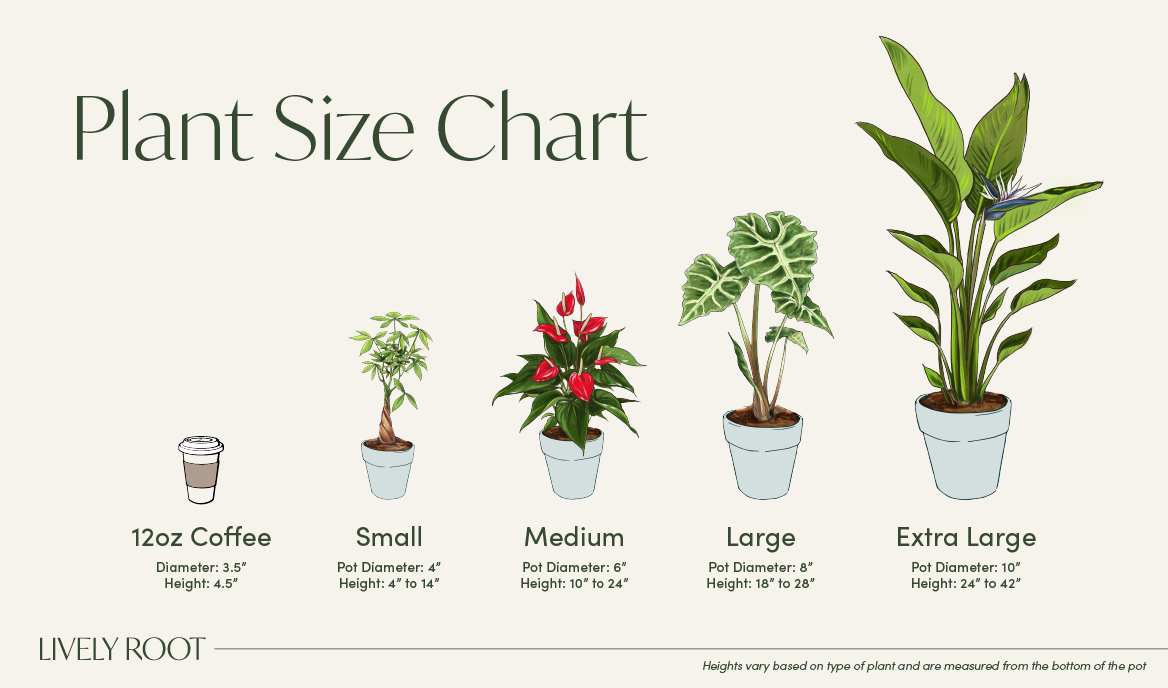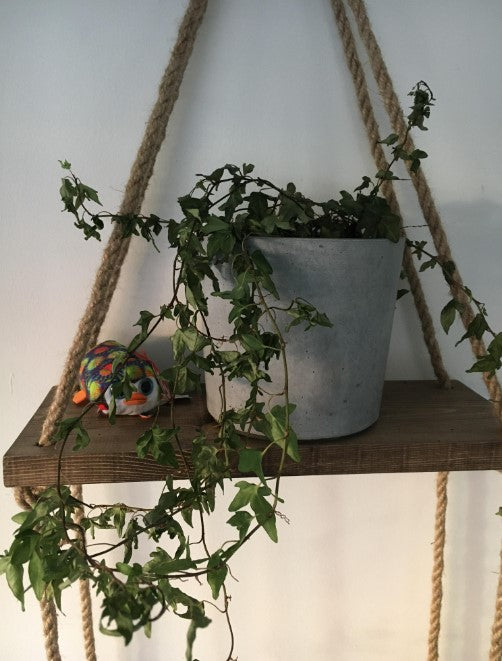

Try our English ivy if you're looking for hanging plants for delivery. Tough but pretty, they stay green all year round and are quite happy in shady spots. They are natural climbers who will crawl and trail up to ten feet. They are easy to care for, too, so you can get those country manor vibes with minimal effort.
Vigorous and fast-growing English Ivy (also known as Hedera helix) is a climbing vine from the family Araliaceae. With medium water and indirect light, English Ivy is deficient maintenance, with an evergreen leaf and an insignificant (if ever) flower. Resilient as ever, they can grow in several conditions and nearly any soil, but they do prefer a rich loam with sufficient drainage.
English Ivy Care Guide & Presentation

This plant loves low to medium indirect light.
Allow the soil to dry out completely between waterings.
Prerfers light humidity. Spritz occasionally.
Keep indoor temps between 60-65°F.
Outside: Grow in morning sun (2-4 hours) to dappled shade the rest of the day. Bring inside if temperatures reach below 35°F.
Indoors: Grow in bright to medium indirect light.
Fertilize once a month during the growing spring and summer by diluting a liquid fertilizer by half strength. Let the plant rest in the fall and winter.
When receiving the plant, do not repot immediately but wait at least 6-12 months or if the roots are beginning to get crowded and growing through the drainage holes.
Repot in the spring, using a 2" bigger pot to keep the roots drier. (Too big of a pot could cause the soil to dry slower, which is not helpful.) Use a well-draining indoor potting mix with perlite to help with drainage.
Water your plant in the old pot before transferring over and let sit an hour. Place a piece of screening at the bottom of the container over the drainage hole to secure the soil and allow to drain. Add soil to the bottom to elevate the root ball. Lift the plant and release the roots against the existing planter. Use a clean knife or garden trowel to wedge between the pot and the soil to loosen.
Inspect the root ball. Notice if there are any dead or rotting roots and trim off with sterile pruners. If the plant is rootbound, cut through the roots to alleviate continued encircling.
Ensure the plant is sitting about 1" below the edge of the pot to avoid water spillage. Add more soil and backfill around the sides by tamping down. Fill up to the soil line but not over.
Water thoroughly, leaving the soil damp but not soggy. If settling occurs, add more soil.
To clean the leaves and alleviate dust particles, give them a shower from above. Fill a watering can with filtered, distilled or tap water that has been sitting for 24 hours. Place the plant in a sink and lightly wash the leaves with a shower spray end watering can.
Trim off any brown leaves with sterile scissors. Remove any debris from the soil and replenish soil if needed. Inspect for any insects at this time.
Take several stem-cuttings up to 6-8 inches off the parent plant. Remove some of the leaves closest to the cutting and place them in a vase filled with water. After several weeks roots will form. After three inches of roots have emerged, use well-draining soil in a small container with drainage. Poke a hole in the soil center. Slip the roots down into it and tamp down the soil around them. Keep the soil moist and watch them grow!
English Ivy: Overview
English Ivy, scientifically known as Hedera helix, is a versatile and resilient evergreen vine. It belongs to the Araliaceae family and originates from Europe, Western Asia, and North Africa.
This hardy ivy plant can thrive in various conditions and is suitable for hardiness zones 4 to 9.
English Ivy is characterized by its glossy, dark green leaves and trailing vines. It is often grown for its ornamental value and can be trained to climb along structures or used as ground cover. While it prefers partial to full shade, it can tolerate some sun. English ivy is relatively easy to care for and is often used in landscaping and indoor settings. However, if ingested, it is toxic to pets.
English Ivy varieties include English Ivy Glacier, English Ivy Gold Child, and English Ivy Deep Green Ripple.
English Ivy Benefits
The English Ivy boasts numerous benefits and holds a special symbolic meaning:
- Its air-purifying properties make it a natural, effective tool for improving indoor air quality.
- This plant has various health benefits, including reducing airborne mold and allergens and promoting respiratory health.
- English Ivy is often used as a symbolic gift or for occasions such as housewarmings, weddings, and anniversaries due to its representation of fidelity, friendship, and protection.
With its lush foliage and trailing vines, this houseplant adds aesthetic appeal indoors as a hanging plant and outdoors as vertical greenery.
English Ivy Care Guide
The English ivy isn’t a demanding plant. Growing it indoors or outdoors is straightforward if you understand its needs. Your ivy will thrive if you know how to care for it and meet its proper water, light, temperature, and humidity requirements.
How Often Do You Water an English Ivy?
Watering your English ivy about twice a week should be enough to prevent underwatering issues. Keep checking the top inch or two of the soil to ensure the plant is thirsty. The trick is to allow the soil to dry between waterings and avoid standing water in the tray, which can lead to root rot. Also, mist the plant 1-2 times a week, especially if the weather is dry.
Does English Ivy like to Be Wet?
English ivy enjoys moderately moist soil and environment, but the potting mix shouldn’t be waterlogged. If the top inch or two of the soil is moist, your ivy is sufficiently hydrated. In addition, make sure that the pot has enough drainage holes to prevent soggy soil and problems that can arise from overwatering the plant.
English Ivy: Temperature, Humidity & Light Requirements
The steps to caring for English ivy include providing the right growing conditions and paying attention to temperature, humidity, and sunlight.
What Temperature Does English Ivy Like?
The English ivy thrives in temperatures between 45°F and 60°F. While it can handle a little drop in temperature, it prefers 40 degrees and above and won’t survive below 23 °F. If you live in a hot region, it can tolerate warmer temperatures of around 70°F - 90°F
English Ivy: Humidity Requirements
The popular ivy plant enjoys average humidity levels of 60%-70%. Make sure it doesn’t go below 40%. You can boost humidity levels by misting your green companion or using a pebble tray. If you want to use a humidifier, set it at 40%-60%. Beware that excessive humidity can encourage pests and diseases.
How Much Light Does an English Ivy Need Indoors?
An English ivy does best in bright, indirect light indoors. A few hours of bright light in the morning or evening can be helpful, but make sure not to scorch the leaves in the afternoon sun. Filtering the light through curtains can help.
At the same time, it may fail to grow correctly and turn leggy in darker conditions. Rotating and adjusting the plant position seasonally can meet its sunlight needs...
How to Propagate an English Ivy
If you want to grow new baby plants, you can propagate your English ivy plant in your home. All you need is a cutting. Start by using sharp shears to cut a 4” —5” piece of the ivy vine. Ensure that the cutting has at least 3-4 leaf nodes.
Dip the cut end into rooting hormone powder and plant it in the potting mix. Root the ivy cuttings in a sandy soil mix. You can also propagate your ivy in water.
Best Soil & Fertilizer for an English Ivy
English ivy loves rich, loamy soil that retains moisture but drains well, with a pH level of 5.5-6.0. Use a grow mix with peat moss or compost in a pot with drainage holes.
Outdoors, their beds can be prepared by amending heavy clay or sandy soils with compost. Applying a 2”-4” layer of organic mulch around the plant bed helps conserve moisture.
During the growing season, spring and summer, feed your ivy every 4 weeks with liquid fertilizer. Dilute a 20-20-20 NPK fertilizer to half the strength before using it.
When to Repot an English Ivy
If you want to repot your English ivy, the best time to do it is in spring and summer when the plant is actively growing. During these seasons, the plant will better establish and strengthen its roots. You only need to repot your ivy every 2-3 years. The new pot should be 1”-2” bigger than the current pot. Remember to be gentle when pulling the plant from its old container. Loosen its root ball and transfer it to its new planter, filled with a quality indoor plant potting mix. Then, water sufficiently your freshly transplanted English ivy.
Trimming and Cleaning an English Ivy
English ivy indoor care involves pruning to keep your plant thriving and prevent leggy growth. It will be happy if you prune it in the spring. You need to pinch or trim the stems above a leaf node.
You should use clean, sterilized shears or scissors. Still, if you want to remove unwanted vine stems and yellow, crispy leaves, gently snap them with your fingers. Cut the vines at the base for outdoor plants instead of ripping them away.
Common English Ivy Problems & Solutions
The English ivy is prone to problems, such as pests, diseases, and environmental stress. Identifying the symptoms and offering care is crucial for maintaining its health and vitality.

Source: Reddit
See below some of the most common issues you can have when growing an English ivy at home:
- Brown, crispy patches on the leaves could be due to dry conditions and overexposure to direct sunlight. Water the plant consistently and protect it from the intense sun rays.
- Curled, yellowing leaves may signal aphids that suck on the sap of the plant. Check new shoots and leaf undersides for insect clusters. Knock them off with water spray and apply insecticidal soap.
- Leaves with yellow dots or red spots often indicate spider mites feeding on the plant juices. You can remove them again by spraying them with water or using a miticide.
- Small bumps on stems and leaves are signs of scale insects, which extract sap and excrete sticky honeydew. Horticultural oil spray can destroy adult pests and their eggs.
- White cottony tufts on the plant are a sign of mealybugs, which leave honeydew and cause stunted growth. Wash them off with water or insecticidal soap.
- Leaf spots or powdery gray coatings indicate fungal disease issues. To prevent these, improve the airflow, reduce environmental moisture, and avoid overwatering the plant. You can also apply a sulfur fungicide.
- Cankers or swollen dead areas on the stems indicate fungus or bacteria. Prune the plant below the affected areas and remove any debris buildup.
English Ivy Companion Plants
Enhance the beauty and vitality of your English Ivy with the following perfect companion plants that complement its lush foliage and trailing vines.
- Spider Plant (Chlorophytum comosum): Known for its air-purifying qualities, the Spider Plant is also loved for its spiky variegated foliage. They are easy to care for and look great set on a tabletop or hung from a macrame sling.
- Golden Pothos Plant (Epipremnum aureus): This low-maintenance plant is reputed to be impossible to kill. It requires minimal water and is more than content in the darker parts of your home, like a north-facing bedroom.
- Neanthe Bella Palm (Chamaedorea elegans): Bring a touch of vibrant greenery to any interior space with the Neanthe Bella Palm. It's renowned for its resilience as it can thrive in various environments, including low-light conditions.
English Ivy Alternative Plants
Explore these alternative pet-friendly plants that offer similar aesthetic appeal and easy care as English Ivy, ensuring a vibrant and safe greenery collection for your home.
- Boston Fern (Nephrolepis exaltata): Renowned for its feather foliage and air-purifying properties, the Boston Fern is a classic choice for indoor greenery, providing a safe and lush environment for you and your pets.
- Peacock plant (Calathea roseopicta): Renowned for its striking foliage patterns and vibrant colors, the Peacock Plant adds a touch of tropical flair to any space while remaining non-toxic to pets.
- Money Tree (Pachira aquatica): Known for its braided trunk and shiny green leaves, the Money Tree is a symbol of prosperity and a pet-safe option that thrives in bright, indirect light. Thus, it is an excellent choice for homes, office spaces, and patios.
English Ivy Care: FAQs
Q: Can English ivy grow in full shade?
A: Yes, English ivy can survive and grow in full shade. But it thrives best in partial shade with filtered sunlight, which prevents leggy or stunted growth.
Q: Does English ivy purify the air?
A: Yes, the English ivy is an air-purifying plant that can enhance indoor air quality. It can remove toxic substances, such as benzene, carbon monoxide, formaldehyde, toluene, trichloroethylene, xylene, etc.
Q: How hot is too hot for an English ivy?
A: If you live in a hot and humid region, your English ivy can grow well when the temperature is below 90°F. If the temperature rises too high and exceeds 110°F , the ivy’s health will deteriorate.
Q: How do you make English ivy bushy?
A: Pruning your English ivy can make it bushy. You can try pinching or snapping long stems and clipping off leggy vines. Also, allow it to grow in bright and indirect sunlight to enhance its appearance and achieve a fuller look.
Q: Is the English ivy a parasite plant?
A: No, the English ivy is technically not a parasite plant. But as it’s a climbing vine that often clings to wooden structures, trees, and stone walls outdoors, it can be destructive and cause damage to your property and outside plants.














































